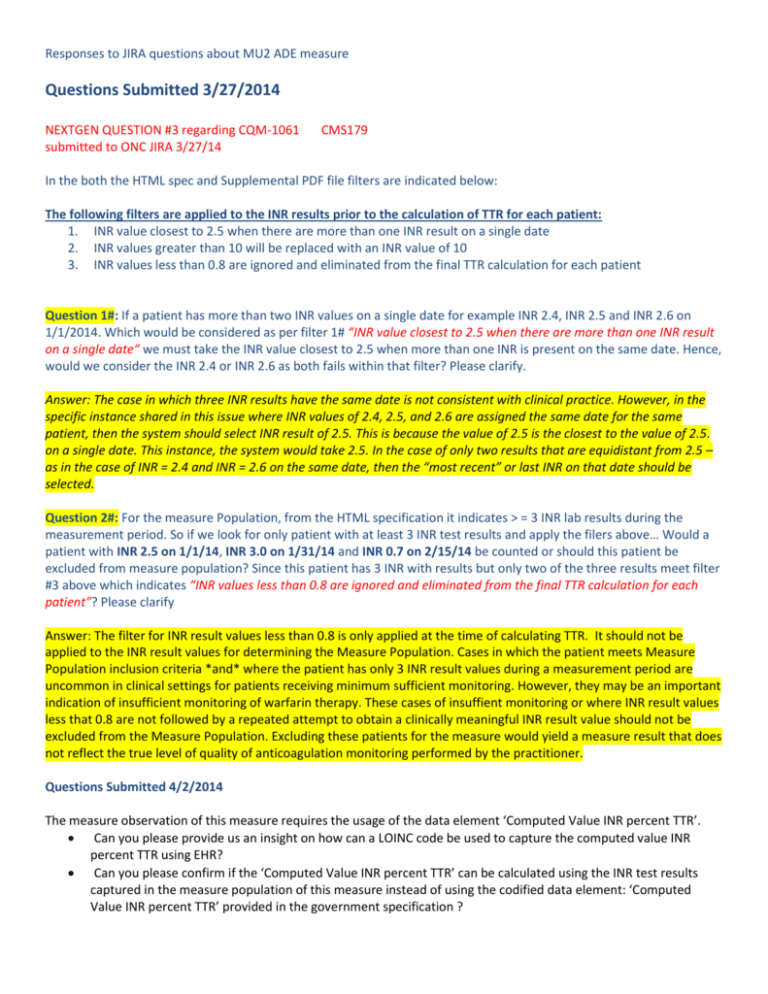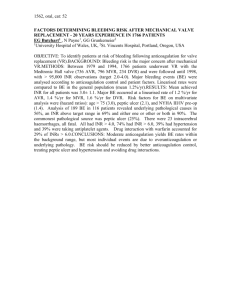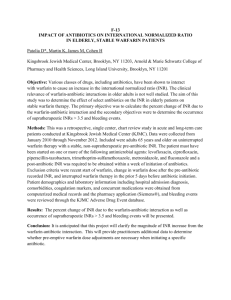JIRA Responses _20140409
advertisement

Responses to JIRA questions about MU2 ADE measure Questions Submitted 3/27/2014 NEXTGEN QUESTION #3 regarding CQM-1061 submitted to ONC JIRA 3/27/14 CMS179 In the both the HTML spec and Supplemental PDF file filters are indicated below: The following filters are applied to the INR results prior to the calculation of TTR for each patient: 1. INR value closest to 2.5 when there are more than one INR result on a single date 2. INR values greater than 10 will be replaced with an INR value of 10 3. INR values less than 0.8 are ignored and eliminated from the final TTR calculation for each patient Question 1#: If a patient has more than two INR values on a single date for example INR 2.4, INR 2.5 and INR 2.6 on 1/1/2014. Which would be considered as per filter 1# “INR value closest to 2.5 when there are more than one INR result on a single date“ we must take the INR value closest to 2.5 when more than one INR is present on the same date. Hence, would we consider the INR 2.4 or INR 2.6 as both fails within that filter? Please clarify. Answer: The case in which three INR results have the same date is not consistent with clinical practice. However, in the specific instance shared in this issue where INR values of 2.4, 2.5, and 2.6 are assigned the same date for the same patient, then the system should select INR result of 2.5. This is because the value of 2.5 is the closest to the value of 2.5. on a single date. This instance, the system would take 2.5. In the case of only two results that are equidistant from 2.5 – as in the case of INR = 2.4 and INR = 2.6 on the same date, then the “most recent” or last INR on that date should be selected. Question 2#: For the measure Population, from the HTML specification it indicates > = 3 INR lab results during the measurement period. So if we look for only patient with at least 3 INR test results and apply the filers above… Would a patient with INR 2.5 on 1/1/14, INR 3.0 on 1/31/14 and INR 0.7 on 2/15/14 be counted or should this patient be excluded from measure population? Since this patient has 3 INR with results but only two of the three results meet filter #3 above which indicates “INR values less than 0.8 are ignored and eliminated from the final TTR calculation for each patient”? Please clarify Answer: The filter for INR result values less than 0.8 is only applied at the time of calculating TTR. It should not be applied to the INR result values for determining the Measure Population. Cases in which the patient meets Measure Population inclusion criteria *and* where the patient has only 3 INR result values during a measurement period are uncommon in clinical settings for patients receiving minimum sufficient monitoring. However, they may be an important indication of insufficient monitoring of warfarin therapy. These cases of insuffient monitoring or where INR result values less that 0.8 are not followed by a repeated attempt to obtain a clinically meaningful INR result value should not be excluded from the Measure Population. Excluding these patients for the measure would yield a measure result that does not reflect the true level of quality of anticoagulation monitoring performed by the practitioner. Questions Submitted 4/2/2014 The measure observation of this measure requires the usage of the data element ‘Computed Value INR percent TTR’. Can you please provide us an insight on how can a LOINC code be used to capture the computed value INR percent TTR using EHR? Can you please confirm if the ‘Computed Value INR percent TTR’ can be calculated using the INR test results captured in the measure population of this measure instead of using the codified data element: ‘Computed Value INR percent TTR’ provided in the government specification ? Answer: The LOINC code for “Computed Value INR percent TTR” (72281-9) represents the ratio of days that a patient’s interpolated INR result is in therapeutic range to the number of days for which the patient has an interpolated INR result. For a given patient, this ratio is can be expressed as either a decimal or a percent. For each patient in the Measure Population, all of the patient’s INR result values that occur during the Measurement Period (minus those filtered out by the three INR result value filters) should be used to calculate ‘Computed Value INR percent TTR’ for each patient. Questions submitted 2/28/2014 1. The following has been mentioned under the population criteria of the government spec: ◦AND: "Patient Characteristic Birthdate: birth date" >= 18 year(s) starts before start of "Measurement Period" However, the CMS179v2 _Supplemental_SQL_Logic_Reference.pdf has the following statement: The logic in this section contains a filter that states the patient must be 18 years or older during the measurement period. Can you please confirm if the patient should be 18 years or older prior to the start of the measurement period or 18 years or older during the measurement period? 2. Based on the Rosendaal method, can you please confirm which of the following is correct in order to calculate the overall % in range? a. % of days in range: To calculate overall % in range, add total days in range for each time period, and divide by total therapeutic days = 63/76 = 83% OR b. % of tests in range: add total tests in range for each time period, and divide by total tests = 4/5 = 80% PLEASE SEE ATTACHMENT FOR GRID RELATED TO THIS QUESTION Responses to 2/28/2014 questions (posted 3/5/2014): RESPONSE to 1. Yes, a patient must be 18 years or older prior to the start of the measurement period. Thus, the “government spec” logic should be used: “AND: "Patient Characteristic Birthdate: birth date" >= 18 year(s) starts before start of ‘Measurement Period’”. We’ll review the supplemental SQL logic for opportunities to align with the HQMF. RESPONSE to 2: The Rosendaal method of calculating “time in therapeutic range” uses ‘number of days’ rather than ‘number of test results in range’. ‘Number of test results in range’ is a different approach, sometimes referred to as “fraction in range”, which is not equivalent to the Rosendaal method. Question 1: Can you please clarify which provider should be used to best determine the provider for INR Tests; should we use the ordering provider for the INR test or the rendering provider on the encounter? As the rendering and ordering provider may or may not be the same provider. We want to ensure we are using the correct provider to best determine/calculate the Average TTR by provider. Answer: The results of the measure should be attributed to the practitioner who is most responsible for managing the anticoagulation therapy for the patient. As indicated by the reporter of this issue, anticoagulation treatment can be managed by different practitioners who, in turn, can take on different roles within anticoagulation management workflow. At this time, we consider this to be an implementation issue and defer to the policy of the CMS EHR Incentive Program for attribution of the results of the measure. Question 2: For each valid INR interval in consideration, can you please confirm to whom and which provider should we count the patients’ TTR towards, if the two tests in an valid INR interval are performed by two different providers? See example below: Example: if we consider the valid INR interval using the Sample 1 and 2 from the below test data, then which Provider should the test be counted for since the difference between the two tests is within range for a patient seem by both providers. Should Provider A receive credit for this internal as he is the provider that initiated the first test between the two tests within this internal? OR Should we only include INR tests for each specific provider and then determine from those specific tests the valid INR intervals for calculating the patients TTR for that provider? Days Since (Date B - Date A) INR Diff (INR BINR A) Pred% In Range Who gets the credit Visit Date Provider INR 12/20/2005 8:29:19 AM A 3.3 6/23/2006 3:09:33 PM B 2.4 9 -0.9 67% A 2 3 4 7/25/2006 2:50:16 PM C 2.5 32 0.10 100% B 8/22/2006 2:49:09 PM A 3.2 28 0.70 71% C 5 8/29/2006 3:07:13 PM A 2.5 7 -0.70 71% A Sample # 1 Answer: As above, the results of the measure should be attributed to the practitioner who is most responsible for managing the anticoagulation therapy for the patient. As indicated by the reporter of this issue and other related issues, anticoagulation treatment can be managed by different practitioners who, in turn, can take on different roles within anticoagulation management workflow. At this time, we consider this to be an implementation issue and defer to the policy of the CMS EHR Incentive Program for attribution of the results of the measure.






